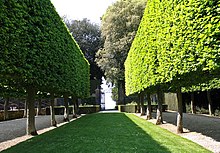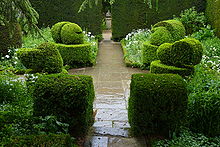Hidcote Manor Garden
History
The Americans, Lawrence Johnston and his mother, settled in Britain about 1900, and Lawrence immediately became a British citizen and fought in the British Army during the Boer war. In 1907 Johnston's mother, Mrs Gertrude Winthrop (she had re-married), purchased the Hidcote Manor Estate. It was situated in a part of Britain with strong connections to the then-burgeoning Arts and Crafts movement and an Anglicized American artistic expatriate community centred nearby at Broadway, Worcestershire.
Johnston soon became interested in turning the fields around the house into a garden. In 1907 he began to lay out the key features of the garden. There are no records to show how many gardeners were employed, but they were directly managed by Lawrence. It was only in 1922, when the garden was essentially complete, that Frank Adams arrived at Hidcote from Windsor Castle to act as head gardener.
The garden became a strong influence on the designer Phyllis Reiss who lived nearby in Dowdeswell Manor. She and her husband bought Tintinhull Garden in Somerset in 1933 so that they could have their own gardens based on the Hidcote Manor style.
After World War II Johnston spent most of his time at Jardin Serre de la Madone, his garden in the south of France; and in 1947 he entrusted Hidcote to the National Trust.
The style of the garden has been widely imitated. In 2007 a temporary garden designed by Chris Beardshaw that drew inspiration from Johnson's Hidcote was constructed at the Chelsea Flower Show in London.
Character of Hidcote garden


Lawrence Johnston was influenced in creating his garden at Hidcote by the work of Alfred Parsons and Gertrude Jekyll, who were designing gardens of hardy plants contained within sequences of outdoor "garden rooms". The theme was in the air: Vita Sackville-West and Harold Nicolson's Sissinghurst Castle Garden was laid out as a sequence of such spaces, without, it seems, direct connection with the reclusive and shy Major Johnston. Hidcote's outdoor "rooms" have various characters and themes, achieved by the use of box hedges, hornbeam and yew, and stone walls. These rooms, such as the 'White Garden' and 'Fuchsia Garden' are linked, some by vistas, and furnished with topiaries. Some have ponds and fountains, and all are planted with flowers in bedding schemes. They surround the 17th century manor house, and there are a number of outhouses and a kitchen garden.
Johnston's care in selecting the best plants is reflected in the narrow-leaved lavender, Lavandula angustifolia 'Hidcote', in the Penstemon 'Hidcote Pink' and in the hybrid Hypericum 'Hidcote Gold', acclaimed as the finest hardy St John's Wort, Alice Coats records.
See also
References
- ^ Clarke, Ethne (1989). Hidcote: Th Making of a Garden. pp. 30–1.
- ^ Clarke. Hidcote. p. 43.
- ^ Pearson, Graham S. (2013). Lawrence Johnston: Creator of Hidcote. p. 75.
- ^ Pearson. Lawrence Johnston. p. 125.
- ^ "TINTINHULL HOUSE, Tintinhull - 1001156 | Historic England". historicengland.org.uk. Retrieved 2 April 2021.
- ^ Flintoff, John-Paul (16 April 2023). "Walking through beauty in hidden gardens of Hidcote". The Guardian. Retrieved 17 April 2023.
- ^ "Chelsea Flower Show 2077:Chris Beardshaw". Retrieved 5 December 2023.
- ^ Coats, Garden Shrubs and Their Histories (1964) 1992, s.v. 'Hypericum'
Further reading
- Clarke, E. (2009) Hidcote: the making of a garden
- Pearson, G. S.; Pavord, Anna (2009). Hidcote: the garden and Lawrence Johnston. National Trust.
- Sackville-West, Vita (1960). Hidcote Manor Garden : Hidcote Bartrim. National Trust/Country Life.
- Whitsey, F. (2011) The Garden at Hidcote